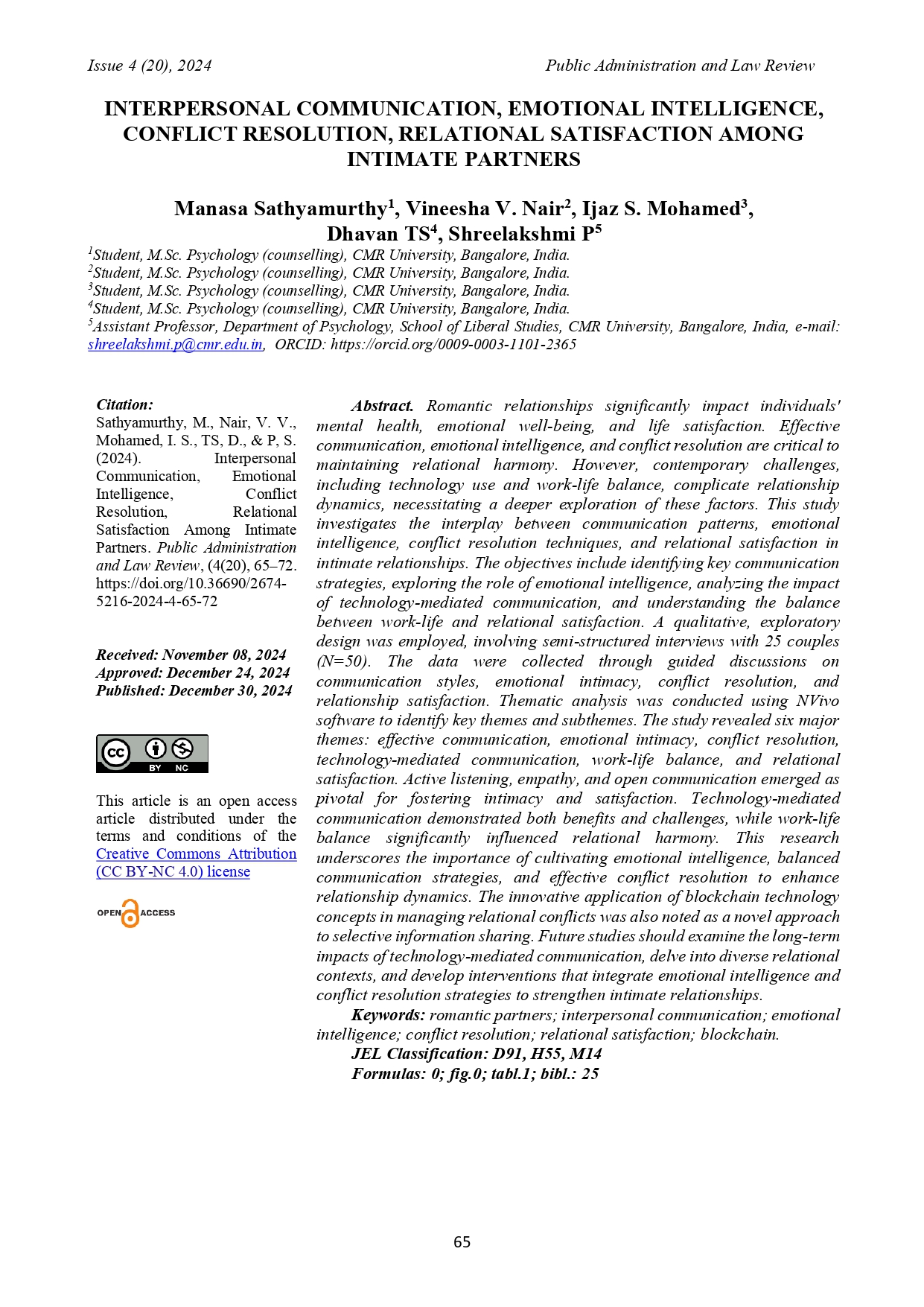INTERPERSONAL COMMUNICATION, EMOTIONAL INTELLIGENCE, CONFLICT RESOLUTION, RELATIONAL SATISFACTION AMONG INTIMATE PARTNERS
DOI:
https://doi.org/10.36690/2674-5216-2024-4-65-72Keywords:
romantic partners, interpersonal communication, emotional intelligence, conflict resolution, relational satisfaction, blockchainAbstract
Romantic relationships significantly impact individuals' mental health, emotional well-being, and life satisfaction. Effective communication, emotional intelligence, and conflict resolution are critical to maintaining relational harmony. However, contemporary challenges, including technology use and work-life balance, complicate relationship dynamics, necessitating a deeper exploration of these factors. This study investigates the interplay between communication patterns, emotional intelligence, conflict resolution techniques, and relational satisfaction in intimate relationships. The objectives include identifying key communication strategies, exploring the role of emotional intelligence, analyzing the impact of technology-mediated communication, and understanding the balance between work-life and relational satisfaction. A qualitative, exploratory design was employed, involving semi-structured interviews with 25 couples (N=50). The data were collected through guided discussions on communication styles, emotional intimacy, conflict resolution, and relationship satisfaction. Thematic analysis was conducted using NVivo software to identify key themes and subthemes. The study revealed six major themes: effective communication, emotional intimacy, conflict resolution, technology-mediated communication, work-life balance, and relational satisfaction. Active listening, empathy, and open communication emerged as pivotal for fostering intimacy and satisfaction. Technology-mediated communication demonstrated both benefits and challenges, while work-life balance significantly influenced relational harmony. This research underscores the importance of cultivating emotional intelligence, balanced communication strategies, and effective conflict resolution to enhance relationship dynamics. The innovative application of blockchain technology concepts in managing relational conflicts was also noted as a novel approach to selective information sharing. Future studies should examine the long-term impacts of technology-mediated communication, delve into diverse relational contexts, and develop interventions that integrate emotional intelligence and conflict resolution strategies to strengthen intimate relationships.
Downloads
References
Altman, I., & Taylor, D. A. (1973). Social penetration: The development of interpersonal relationships. Holt, Rinehart & Winston.
Baxter, L. A., & Montgomery, B. M. (1996). Relating: Dialogues and dialectics. Guilford Press.
Bary, S. (2019). Disengaged couple communication and depressive symptoms: A dyadic analysis. Journal of Family Psychology, 33(7), 869-878.
Christensen, A., & Heavey, C. L. (1990). Gender and social structure in the demand/withdraw pattern of marital conflict. Journal of Personality and Social Psychology, 59(1), 73-81.
Cloutier, G. (2021). Sexuality, intimacy, and communication in romantic relationships for individuals with psychotic disorders: A systematic review. Psychiatric Rehabilitation Journal, 44(2), 101-114.
Cordova, J. V., Gee, C. B., & Warren, L. Z. (2005). Emotional skilfulness in marriage: Intimacy as a mediator of the relationship between emotional skilfulness and marital satisfaction. Journal of Social and Clinical Psychology, 24(2), 218-235.
Coyne, S. M., Stockdale, L., Busby, D., Iverson, B., & Grant, D. M. (2011). "I luv u :)!": A descriptive study of the media use of individuals in romantic relationships. Family Relations, 60(2), 150-162.
Chen, C. (2021). Strategic communication approaches to enhance relationship negotiation. Conflict Resolution Quarterly, 38(2), 125-142.
Emmers-Sommer, T. M. (2004). The effect of communication quality and quantity on intimacy and structure in romantic relationships. Marriage & Family Review, 39(1-2), 21-44.
Gilliland, R., & Dunn, T. P. (2003). Conflict resolution strategies in romantic relationships. Research Summary, 29(1), 40-46.
Gottman, J. M., & Silver, N. (1999). The seven principles for making marriage work. Three Rivers Press.
Gottman, J., & Gottman, J. (2017). The natural principles of love. Journal of Family Theory & Review, 9(1), 7-26.
Guerney, B. G. (1977). Relationship enhancement. Jossey-Bass.
Gupta, S. K., Uygun, S. V., Reznik, N. P., & Sipahi, E. (2020). Significance of the traditional conflict resolution mechanism in present social scenario: A case study of Ethiopian conflict management system. Revista Gestão em Análise, 9(2), 122-134.
Hazan, C., & Shaver, P. (1987). Romantic love conceptualized as an attachment process. Journal of Personality and Social Psychology, 52(3), 511-524.
Jolin, A. (2024). Communication patterns and relationship satisfaction: A longitudinal analysis. Journal of Family Communication, 24(1), 22-34.
Janning, M. M., Kailing, J., Leonard, C., & Nave-Blodgett, J. E. (n.d.). The role of communication format in long-distance romantic relationships. Journal of Social and Personal Relationships.
McDaniel, B. T., Drouin, M., & Cravens, J. D. (2017). Do you have anything to hide? Infidelity-related behaviours on social media sites and marital satisfaction. Computers in Human Behaviour, 66, 88-95.
Pereira, V. H., Vandenberghe, L., Eliz, R., & Uebler, D. (2022). Communication patterns, forgiveness, and physical-psychological morbidity in young adults: A transactional approach. Journal of Clinical Psychology, 78(4), 464-475.
Petronio, S. (2002). Boundaries of privacy: Dialectics of disclosure. SUNY Press.
Sharma, A., Patel, R., & Gupta S. K. (2024). Bridging the gap: Organizational communication as a mediator between emotional intelligence and turnover intention. Journal of Applied Psychology.
Solomon, D. H., & Knobloch, L. K. (2004). A model of relational turbulence: The role of intimacy, relational uncertainty, and interference from partners in appraisals of irritations. Journal of Social and Personal Relationships, 21(6), 795-816.
Solomon, D. H., Knobloch, L. K., Theiss, J. A., & McLaren, R. M. (2016). Relational turbulence theory: Explaining variation in subjective experiences and communicative processes of romantic relationship development. Human Communication Research, 42(4), 507-532.
Walster, E., Walster, G. W., & Berscheid, E. (1978). Equity: Theory and research. Allyn and Bacon.
Zeidner, M., Matthews, G., & Roberts, R. D. (2013). Emotional intelligence, conflict resolution patterns, and relationship satisfaction: A study of a large industrial sample using the MSCEIT. Motivation and Emotion, 37(2), 308-323.

Downloads
Published
How to Cite
Issue
Section
License

This work is licensed under a Creative Commons Attribution-NoDerivatives 4.0 International License.





